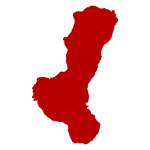The diwal or angel wings clam (Pholas orientalis) is a highly seasonal shellfish in the Philippines and prized for its delectable and succulent taste. Diwal thrives in the sandy-muddy bottoms of inter tidal areas in coastal waters of Iloilo, Capiz and Negros Occidental.
I remember eating them while growing up in Iloilo but I haven’t had the fortune to encounter them again. That was so long ago that I can no longer remember how it tastes.
Diwal in Hiligaynon means “sticking out the tongue” and the shellfish probably got it’s local name because it’s “feet” sticks out of it’s shell like a tongue when alive. It’s English name was due to the fact that it’s shells are like angel wings when fully opened.
These clams were on the brink of extinction a few years ago because of over harvesting. A total ban in the harvesting of diwal was enforced in Capiz in the late 1990’s in order to protect and rehabilitate the remaining traditional diwal grounds.
Harvesting of Diwal
Fisherfolks of Valladolid, Negros Occidental happily observed that there is a resurgence in the volume of diwal this year. Harvesting of Diwal in Valladolid is only done during the months of January to April and the ideal size should be 3 inches (7.6 cm) and above. May to December is considered closed season because it is during these months that diwal is allowed to grow.
Only residents of Valladolid are allowed to harvest diwal in their shores and should first secure a mayor’s permit. Harvesting time is only from 6am to 10am. Diwal clams are harvested by divers up to 8 meters deep. When you happen to pass by Valladolid, you’ll notice bamboo poles sticking out of the water. These poles are used by the divers to hold on to when diving for Diwal.
It’s fortunate that I happen to pass by Valladolid last week so I bought a kilo of diwal from the vendors along the sidewalk. The man offered it to me for P250 which is quite expensive since it’s the price of diwal in Bacolod. I haggled for P200 but I ended up buying it at P220. Yes, I suck at haggling. I thought, I don’t haggle at the supermarkets so might as well give him the extra P20. Diwal can be had for P250-400 in Bacolod markets so I still got a good bargain.
How to Cook Diwal
I haven’t tried cooking diwal so I asked the vendor how to clean it. He demonstrated to me how to pry open the shell with a knife and then slice the meat inside and then wash it with water to remove the sand. His other special instructions were not to add salt and never overcook.
At home, I did exactly as told and brushed the shells to remove the dirt and then place the diwal over charcoal. As soon as the meat turns a little brownish and the juice comes out of the meat then they’re ready to eat. I easily understood the man’s warning not to overcook since they would lose much of their juice.
And the verdict? Really, I’ve never tasted a shellfish as soft, succulent and sweet as diwal. Diwal tastes heavenly! No wonder they’re sought after for they taste like no other shellfish. Grilled diwal is a perfect pair for laswa, or vegetable stew. Diwal can also be steamed with lemongrass and ginger to enhance its flavor. They can also be baked which most restaurants in Bacolod serve when diwal is in season.
Thank heavens diwal is still around today so that we can still enjoys its heavenly flavors.

